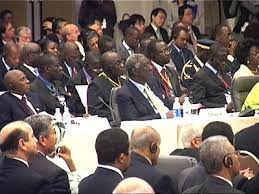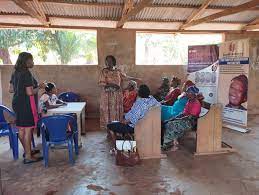By Bunmi Makinwa

WRITTEN IN JUNE 2008
In attendance were a King, Presidents, Vice-Presidents,and Prime Ministers from 40 African countries. From the rest of the continent were Ministers and senior political leaders. It looked very much like a summit of African heads of state and government in Yokohama, Japan. But it was not a summit.
It might also look like some version of the World Economic Forum. There were many roundtables, side meetings and events at a secure location where one ran into the top figures of politics, business, entertainment and development at every corner.
In reality, it was the fourth Tokyo International Conference on African Development (TIKAD IV) being held in the famous Japanese city from May 31 to June 1 2008.
Many UN agencies were represented at the highest level, and Thoraya Obaid was there as headof UNFPA. Bono, Bob Geldof, and Jeffrey Sachs – well-known spokespersons on development in Africa – were also there.
Those who could not attend the high-level event wrote opinion pieces in a special English edition of the Asahi Shimbum of May 31 – June 1, 2008. The opinion writers included Bill Gates, Kofi Annan, George W. Bush, Giorgio Amani, and Sarah Brown, wife of Prime Minister Gordon Brown of the U.K.
There was no question that it was a gathering of big names. They would take yet another look at the past, understand the present, and prepare for the future development of Africa.
Talks Continue

The conversations on African development were taking on a new impetus. The TICAD IV provided a window into how the conversations were shaping up – issues, actors, players and actions come together to check positions and decide on the next actions.
But the reality might be different. Whilst commitment was obvious, there was no convergence on how to bring about development in Africa.
Maybe this was indeed how it should be – the notion of development could be seen from different optics. Although there is one African continent,it ismany countries with varying challenges, and the countries show different levels of progress and limitations.
The statements and speeches from African political leaders and their declared partners showed some clarity on what was required for African countries to develop. Problems were stated and solutions were proposed. Many of the statements were similar to the ones made previously by the same persons at international meetings and conferences. Less clear though was whether the continent has made progress because of what was said and repeated so often.
It made one wonder if underdevelopment in Africa was in large part due to too much being said and too little being done.
In this century, will Africa become a principal player inthe globalagenda? Or to put it starkly, will major development take place in a critical number of African countries in a way that would catalyse the resurgence of the continent as one of the major poles in the discourse of world political, economic or social directions? Would a more developed Africa evolve shortly? Would Africa set itsglobal agenda?
Promising Openings

Going by the efforts and preparations put into organizing TICAD IV by Japan, and the convincing attendance by African leaders, the two parties would seem to believe in the future of Africa. They were sure that they could work together towards it, both in symbolic ways and in concrete actions.
For the African continent, the statistics were promising. Most countries have recorded solid economic growth over the past several years. Real GDP has increased steadily since 2000 with an overall annual average rate of about 6percent,well beyond the world average. Besides the global commodity boom and its effects on resource-rich African countries, most of Africa made progress. The good outcomes were attributed mostly to sound economic management and expansion of trade and investment which resulted from political stability.
Even innon-resource-richAfrican countries (those mostly without petroleum or huge mineral wealth), some commendable “prosperity” wasapparent, going by macroeconomic indicators.
The exceptions were countries that had major conflicts, or those countries in post-conflict stages, where rebuilding the economy was a major challenge.
What was the reason for such positive growth in Africa? Perhaps therein lay the answer to the key questions.
Rich But Poor

Despite the noticeable growth, poverty remained acute. Social development was very low and for many peoples, almost non-existent. Economists, who made positive statements about strong macro-development in Africa, admitted that there wasa hugedeficiency in micro-development. It was another economic jargon that translated as “there are good economic indicators in the country, but the life of the common citizens has not improved”.
Many African political leaders questioned their economic advisers on whether economic development, especially macroeconomic development, could bring about desirable social development. And when would it start to manifest in the human advancement trajectory?
The new and obvious plurality of political parties and democratic governance in Africa forced elected political leaders to become impatientwith dry statistics on economic and social development. The politicians were keen to point out that infrastructural development and access to social services were available due to their (leaders) governance.
Trade Needs

It was no wonder therefore that President Jayasha Mrisho Kekwete of Tanzania, the then President of the African Union, called at TICAD IV for more trade and not aid. He noted that direct investment by Japanese firms in sub-SaharanAfrica only accounted for 0.4 per cent of Japan’s total foreign direct investment of US$108.5 billion between 2002 – 2004. “Africa is a far-off land, too risky to invest in” for Japanese investors, he chastised and urged that the wrong perception of the continent should change. “Returns on investment in Africa are much higher than are available in the traditional low-risk, more stable world,” he declared.
Discriminatory policies and trade practices against African countries were some of the major obstacles imposed by Western countries to deter economic prosperity. To further make the point, Uganda’s President Yoweri Museveni jokingly said that he could provide beef for Japanese consumers at $20 per kilo compared to the price of about $200 per kilo paid for the famous Kobe beef.
He said that the Japanese farmers would not have to play classical musicor provide body massage and wine any longer to their coveted cows. Museveni said that Uganda would providehigh-quality beef at much cheaper prices. “In such a trade, huge savings are possible for Japan, and great benefits would accrue to Uganda,” he said, “merely by removing self-imposed and expensive care for cows just for having good beef!”
Prime Minister Yasuo Fukuda of Japan pledged to double Japan’s annual net official development assistance to Africa to US$1.8 billion by2012 and to extend up to $4 billion in new loans over the next five years. Most of the support will go into the bilateral cooperation that was already established.
The investment will focus on infrastructure improvement, and agriculture, especially rice production. On the “soft development” side, mother-child health care would get substantial support from Japan., according to the Japanese leader.
Future Steps
The conference had a four-pronged thematic direction – economic growth; human security and MDGs; peace and democratization; and environment and climate change.
The outcomes of the TICAD IV conference would feed into the coming G8 summit of July 7-8 where sexual and reproductive health, maternal health and AIDS would also feature prominently.
Achieving the MDGs and related social development was seen as a crucial part of economic and infrastructural development. The challenge was how to make policies and implement them to attain both economic and social development – the two sides of the coin. From experiences in some parts of the world, it was possible.
In a few African countries, infrastructural development was moving ahead at a brisk pace, despite the late start. However, most African countries had very limited number of the basic infrastructures needed.
Some African leaders and individuals were listed amongthe world’s richest. But huge segments of the population remained far from having any meaningful access to decent means of livelihood. The gap between those who have and those who could not have was still growing, rather than narrowing.
Bunmi Makinwa
June 2008